10 Best Binoculars in Canada of 2024: Reviews & Top Picks
Last Updated on
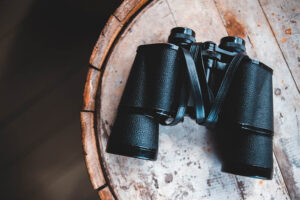
Whether you need binoculars for hunting, birdwatching, stargazing, or just to watch your favorite sports team from the cheap seats, you need a pair that works. Finding the best binoculars means knowing what you need them for, how much weight you’re willing to carry, and what you can afford to spend.
Luckily, you don’t have to spend a fortune to get a great pair of binoculars. These reviews will give you the 10 best binoculars in Canada for this year, and the buyer’s guide will tell you exactly what to look for, so you get the ideal pair to suit your needs!

A Quick Look at Our Favorites in 2024
| Image | Product | Details | ||
|---|---|---|---|---|
| Best Overall |
 |
Celestron TrailSeeker 8x42 |
|
CHECK PRICE |
| Best Value |
 |
Nikon ProStaff 3S 10x42 |
|
CHECK PRICE |
| Premium Choice |
 |
Celestron SkyMaster Pro 20x80 |
|
CHECK PRICE |
 |
Celestron Outland 8x42 |
|
CHECK PRICE | |
 |
Canon 10x42L IS WP |
|
CHECK PRICE |
The 10 Best Binoculars in Canada
1. Celestron TrailSeeker 8×42 — Best Overall
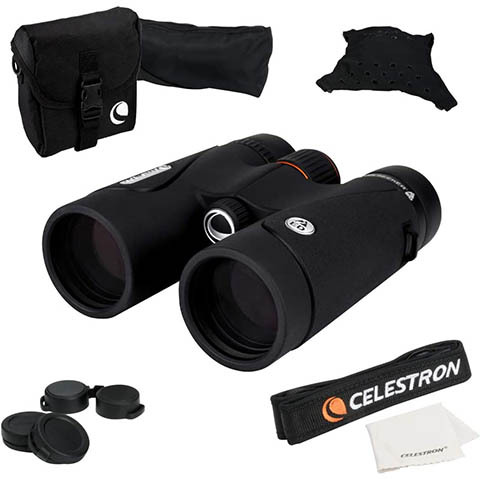
| Magnification: | 10x |
| Objective Diameter: | 42 mm |
| Weight: | 655g/23.1 oz. |
| Closest Focusing Distance: | 2 m |
Our pick for the best overall binoculars in Canada is the Celestron TrailSeeker 8×42. These perfectly balance image quality, durability, and portability. They are affordable without sacrificing quality, with clear images across the board. The optical highlight includes a wide viewing field and the ability to focus close up.
We’re also impressed by the extras included with these binoculars, including a harness and a carrying sack. This is a great option to step up to a full-size set of binoculars. The only negative thing is that the lens caps occasionally pop loose. This can be fixed by attaching them to the binoculars, but they don’t come that way.
- High-quality images
- Lightweight and compact
- Waterproof
- Harness and carrying sack included
- Loose lens caps
2. Nikon ProStaff 3S 10×42 — Best Value
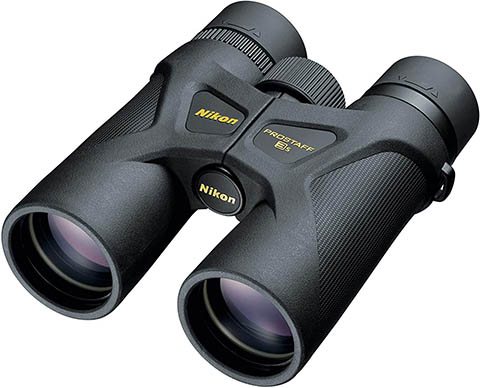
| Magnification: | 10x |
| Objective Diameter: | 42 mm |
| Weight: | 575g |
| Closest Focusing Distance: | 3m/10ft. |
The best binoculars in Canada for the money are the Nikon ProStaff 3S. While Nikon is famous for its cameras, its superior image quality transfers over to its binoculars. The company has paid so much attention to detail in its lens design that these binoculars won the Red Dot Design Award.
With non-slip construction and armored outsides, this is a rugged set of binoculars. A silver alloy mirror coating on the prism lenses provides a clear view that can be enjoyed for long periods of time thanks to long eye relief. This set is also fog proof, with a fully waterproofed seal.
The biggest downside to this set of binoculars is the lack of portability. They are neither lightweight nor small, so they aren’t particularly easy to haul around.
- Well suited to wildlife viewing
- Sturdy exterior construction
- Waterproof
- Long eye relief
- Fog-proof lenses
- Heavy
- Large
3. Celestron SkyMaster Pro 20×80 — Premium Choice
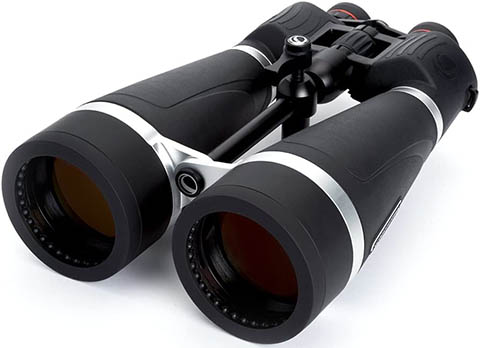
| Magnification: | 20x |
| Objective Diameter: | 80 mm |
| Weight: | 2.45 kg |
| Closest Focusing Distance: | 20.2 m |
The Celestron SkyMaster Pro 20×80 binoculars are specifically designed for stargazing. They’re not portable and are meant for tripod viewing. While they don’t come with a tripod, they do have a built-in center support to make them sturdy when attached to one. These offer incredible magnification and superior light-gathering, so they can be used at night, dusk, and dawn to give you a better view of the stars.
The lenses on the Celestron SkyMaster are fog proof and waterproof, while the binoculars themselves are made from aluminum and polycarbonate.
- High magnification
- Built-in center support for tripod mounting
- Superior light-gathering abilities
- Waterproof
- Fog-proof lenses
- Best used on a tripod
- Big and bulky
- Expensive
4. Celestron Outland 8×42
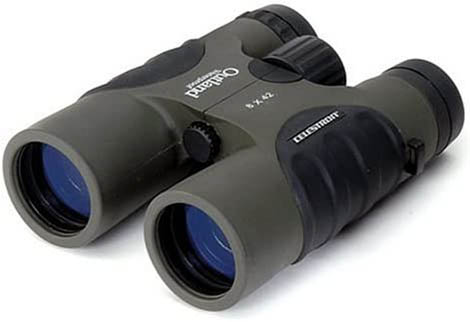
| Magnification: | 8x |
| Objective Diameter: | 42 mm |
| Weight: | 624 g/22 oz. |
| Closest Focusing Distance: | 3.96 m/13.1 ft. |
The Celestron Outland 8×42 binoculars are well-suited to bird and wildlife watchers, as they offer 8x magnification, waterproofing, and a sturdy polycarbonate build. These lenses gather a ton of light, making them suitable for use in dim light conditions. The focus wheel is easy to use, and the eye relief offers to view comfort for long periods.
If you desire, these binoculars can be tripod mounted. The box includes a carrying strap, a lens cloth, and a convenient carrying case. Celestron also offers a lifetime warranty.
- Well-suited to wildlife viewing and bird watching
- Sturdy housing
- Waterproof
- Large and heavy
5. Canon 10x42L IS WP
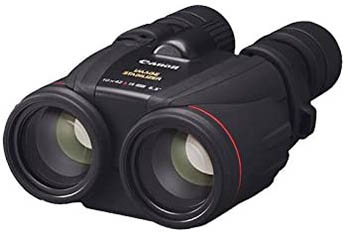
| Magnification: | 10x |
| Objective Diameter: | 42 mm |
| Weight: | 1.1 kg |
| Closest Focusing Distance: | 2.5 m |
The IS in Canon’s binocular line denotes that they are image stabilized. Canon offers a battery-operated option, so you can get a clear, wobble-free image with just a press of a button. The effect is instant and spectacular.
The rubber coating offers waterproofing and durability, so they are suitable for extended outdoor pursuits. This model of binoculars is part of Canon’s premium line, so it has clear views in adverse conditions. Along with stability, these binoculars can fit comfortably in your hand and have long eye relief and a large exit pupil for a wider field of view. They have a closer focusing distance than most other options too.
Unfortunately, Canon’s stabilized options are heavier than its non-stabilized models. Since these binoculars weigh over 1 kg, they can be weighty to lug around.
- Image stabilizing
- Battery-operation option
- Weatherproofed
- Closer focusing distance than most other options
- Bulkier than non-stabilized models
- Heavy
6. Opticron Savanna WP 6×30
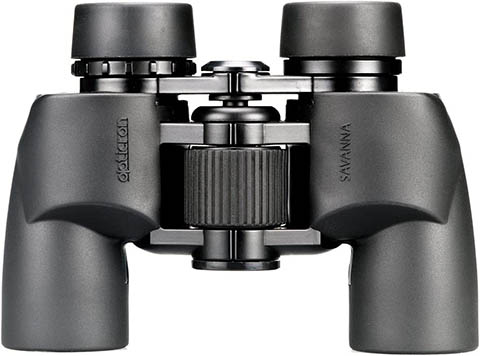
| Magnification: | 6x |
| Objective Diameter: | 30 mm |
| Weight: | 485g |
| Closest Focusing Distance: | 3 m |
Opticron Savanna WP 6×30 is a great set of lightweight, portable, waterproof binoculars. This is a great choice for beginners or kids who need something easy to haul around. It’s compact enough for small hands to hold comfortably but has a wide field of view for curious minds.
While these aren’t the most powerful binoculars on this list, they are easy to use. They lack features like anti-fog, so they’re not ideal in inclement conditions.
- Lightweight and compact
- No eyestrain
- Only 6x magnification
- Lack of features like anti-fog
7. Olympus 10×42 Pro
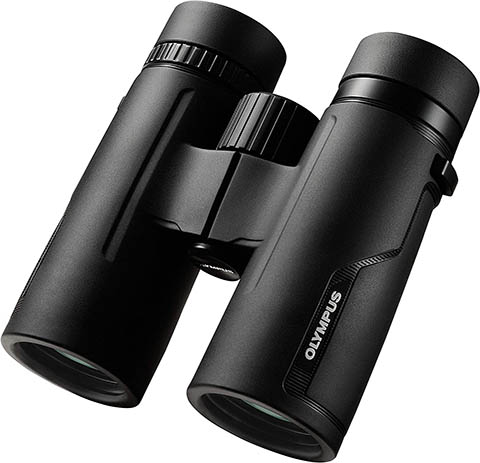
| Magnification: | 10x |
| Objective Diameter: | 42 mm |
| Weight: | 665 g |
| Closest Focusing Distance: | 1.5m |
The Olympus Pro line offers sharp and reliable binoculars with a nano coating. The company is well-known for its optical expertise in its camera systems, and its binoculars offer the same high-performance optics.
This compact set has rugged construction and maintains its structural and functional integrity even if submerged in water for up to 5 minutes. With close-vision clarity at 1.5 m, the viewing ability is impressive. The lenses are filled with nitrogen gas to prevent fogging, and they have extendable eye relief for individuals who require glasses. Olympus offers a 15-year warranty, which may provide peace of mind if you tend to be hard on your gear.
The magnification on these binoculars may not be high enough for avid wildlife watchers, as they work better at short distances.
- Lightweight and compact
- Waterproofed up to 1 m for 5 minutes
- Nitrogen-filled lenses for anti-fogging
- 15-year warranty
- Not enough magnification for wildlife viewing
- More expensive than most other brands
8. Leica Trinovid HD 10×42
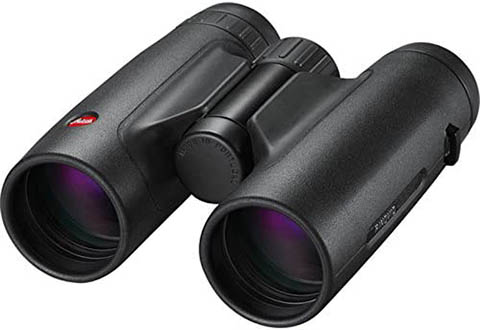
| Magnification: | 10x |
| Objective Diameter: | 42mm |
| Weight: | 730g |
| Closest Focusing Distance: | 1.6m/5.3 ft. |
For bird watchers, we recommend the Leica Trinovid HD 10×42. These binoculars are also a solid, all-around option, as they combine superior image performance and a rugged exterior that will withstand just about anything.
These binoculars are ergonomically designed, so they’re easy to hold onto and you won’t lose grip. They have both long-distance and short-distance clarity, so you can track with them, and their image stays consistent in bright and low-light conditions. They also have incredible color-defining capabilities, which is what makes them such good options for birds.
The most unfortunate thing about these binoculars is that while they come with luxury capabilities, they also have a luxury price tag. The cost may put them out of range for some customers.
- Rubber armor coating
- Superior image sharpness
- Good long-distance and short-distance clarity
- Excellent color distinction
- Ergonomic design
- Luxury price tag
9. Nikon Monarch HG 10×30
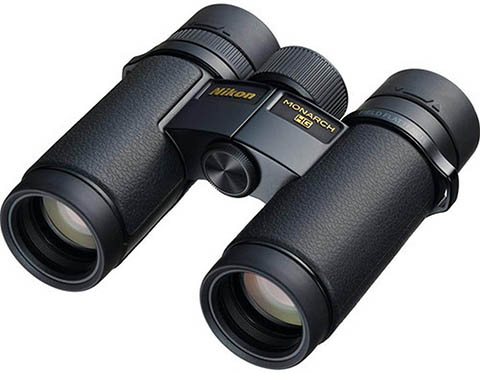
| Magnification: | 10x |
| Objective Diameter: | 30mm |
| Weight: | 450g |
| Closest Focusing Distance: | 2 m/6.6 ft. |
The Nikon Monarch HG 10×30 is lightweight, compact, and portable. It’s built with a magnesium alloy that provides water and fog proofing. ED (extra-low dispersion) glass corrects color fringing. These binoculars come with a soft neck strap and a semi-hard case that protects them from damage during travel. They are tripod mountable, but you will have to purchase the tripod adaptor separately, which unfortunately adds to their overall cost.
Their compact design also gives them a high price tag. The 42-mm version of these Nikon Monarch binoculars is available at a lower price but isn’t nearly as portable.
- Wide viewing angle
- Waterproof and fog proof
- Magnesium-alloy build
- Compact and lightweight
- Premium price tag for a compact build
10. Vixen SG 2.1×42 Constellation Observation Binoculars
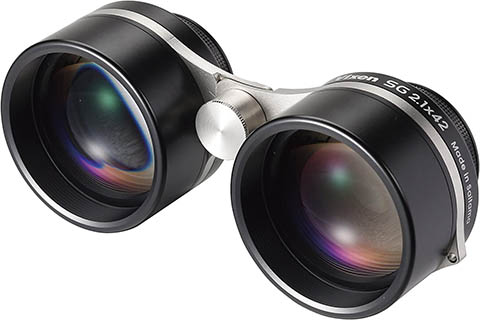
| Magnification: | 2.1x |
| Objective Diameter: | 42 mm |
| Weight: | 410g/14.5 oz. |
| Closest Focusing Distance: | 2 m |
The Vixen SG 2.1×42 steps up to the plate for immersion rather than magnification. You wouldn’t use these binoculars for wildlife or birdwatching, but they are perfect for stargazers. While the magnification is low, this allows a clear, wide-angled view of the night sky.
If you prefer stargazing with your naked eye as opposed to using high-powered telescopes, these binoculars enhance your vision while retaining your natural view.
The lens caps on the Vixen SG frequently pop loose and are easy to lose. The lack of magnification also makes the edges of your viewing field blurry, which may be frustrating to some users.
- Portable
- Unique viewing field
- Lack of magnification
- Blurry edges
- Easy-to-lose lens caps

Buyer’s Guide: Choosing the Best Binoculars in Canada
What to Look For in Binocular Specs
There are many different specs on binocular sets, but the only two that you should really focus on are magnification and lens size.
Most binocular models list these two specs right in the name, with measurements like “10×20” or “6×30.” These numbers refer to the lenses’ magnification and size, respectively. While it seems like a higher magnification is always the best choice, this usually sacrifices your field of view and can make things harder to find.
Larger lenses provide clearer, brighter images than smaller lenses, particularly in low-light conditions. However, large lenses also make binocular sets bigger and heavier, so there’s the tradeoff.
Before purchasing a set of binoculars, it’s best to consider what you want to use them for most of the time. While many of these binoculars can be used for general activities, if your primary hobby is birdwatching, you should focus on buying binoculars that fit that purpose.
What You Need for Different Purposes
- Binoculars for Stargazing
If you are an amateur astronomer and primarily need stargazing binoculars, we recommend a binocular size of around 7×50. 7x magnification is more than enough to get a good look at the sky and will avoid compromising your field of view. A 50mm lens offers plenty of light transmission for viewing far-off celestial objects.
- Binoculars for Horse Racing or Sports
Sporting events usually happen in daylight conditions, so you don’t necessarily need a bright objective lens. An 8×30 will do. The magnification level is enough to see from even distant seats, and you won’t have to lug around a big, heavy set of binoculars.
- Binoculars for Nature Watching
For wildlife or birdwatching, look for high magnification levels combined with a light and a small lens. Anything in the 10×26 range should do the trick. If you want something more, consider buying binoculars that can be attached to a tripod, so you don’t get fatigued from holding them up.

Conclusion
Hopefully, you now have a good idea of the best binoculars to meet your needs. We recommend the Celestron TrailSeeker 8×42 as the best overall binoculars in Canada. These compact and portable binoculars offer a clear image, making them a good option for all-around use. The best binoculars in Canada for the money are the Nikon ProStaff 3S 10×32. This set offers superior quality and performance at a more affordable price tag than many other options.
Featured Image Credit: Erik Mclean, Unsplash
Table of Contents
- A Quick Look at Our Favorites in 2024
- The 10 Best Binoculars in Canada
- 1. Celestron TrailSeeker 8×42 — Best Overall
- 2. Nikon ProStaff 3S 10×42 — Best Value
- 3. Celestron SkyMaster Pro 20×80 — Premium Choice
- 4. Celestron Outland 8×42
- 5. Canon 10x42L IS WP
- 6. Opticron Savanna WP 6×30
- 7. Olympus 10×42 Pro
- 8. Leica Trinovid HD 10×42
- 9. Nikon Monarch HG 10×30
- 10. Vixen SG 2.1×42 Constellation Observation Binoculars
- Buyer’s Guide: Choosing the Best Binoculars in Canada
- Conclusion
About the Author Chelsie Frasier
Chelsie is a freelance writer who is passionate about pets, animals and all things optical. She currently lives in rural Alberta, Canada with her husband and two sons, and is a pet parent to a Border Collie, four cats and four horses.
Related Articles:
When Were Binoculars Invented? History, Today & Future
How to Choose Binoculars for Bird Watching: 10 Expert Tips
How to Collimate Binoculars: 9 Expert Tips
Binocular Magnification Chart: Numbers & Distances Compared
What Is the Best Binocular Magnification for Hunting? Optical Features Explained
Can You Use Binoculars to Look At Stars? How to Choose the Right Pair
What Does 20X50 Mean on Binoculars? Our Helpful Guide
Infrared Binoculars vs. Night Vision: Which Should I Choose?



